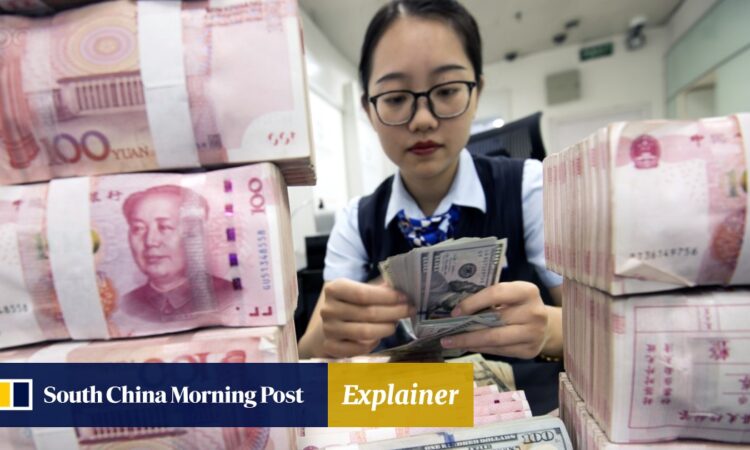China’s yuan: how far will Beijing go to support its currency after slide to 16-year low against the US dollar?

And analysts have said that it still has the tools, including using its massive foreign reserves to prop up the currency.
What has been driving the yuan’s weakness?
A poor business outlook and the widening yield gap between China and the United States have been the main drivers for the weakness of the yuan.
A weak currency has also aided China’s trade data amid its slower than expected recovery, making its exports cheaper.
In 2022, China ran a record trade surplus in goods, a key source of the country’s foreign exchange, as its exports have consistently outpaced imports in recent years.
The interest rate cuts by People’s Bank of China (PBOC), aimed at supporting the economy, might have also add some pressure on the yuan.
How weak will the yuan get against the US dollar?
The yuan extended its fall to 7.35 against the US dollar on Friday, the first time since December 2007.
The offshore yuan, traded outside mainland China, also weakened to around 7.36 per US dollar on Friday morning, approaching the lowest level on record.
The Chinese currency may weaken further to 7.4 in the third quarter, but may rebound to 7.2 by the end of the year, according to a forecast by Bank of America.
Much of the yuan’s exchange rate will be driven by whether there is a meaningful policy response to the downward pressure on the economy in the coming weeks that could stabilise the yuan.
I’d say the risk to the forecast is on the upside
“If we don’t get that, particularly in the next few weeks, I’d say the risk to the forecast is on the upside, it could be 7.4 or 7.5 or 7.6,” said Adarsh Sinha, co-head of the Asia rates and currencies strategy team at Bank of America.
What has Beijing done so far to help the yuan?
There have also been media reports suggesting that the PBOC had asked commercial banks to sell US dollars and buy the yuan.
The central bank has continued to set the yuan midpoint firmer than market projections, which traders have interpreted as signs that the PBOC is not comfortable with the yuan’s weakness.
‘Momentum remains lukewarm’: 4 takeaways from China’s trade data in August
‘Momentum remains lukewarm’: 4 takeaways from China’s trade data in August
The yuan midpoint is a reference point for trading, and the currency is allowed to trade 2 per cent above or below the midpoint fixed by the PBOC each trading day.
The central bank has also raised the cross-border macro prudential adjustment ratio for corporate and financial institutions, making it easier for domestic firms to raise funds from overseas markets.
Sinha at Bank of America also noted that over the past couple of weeks the funding costs of the offshore yuan, which is traded outside mainland China, has increased, making it more expensive for investors to borrow and short sell the offshore yuan and buy the US dollar. Short selling is a way of speculating on assets or securities that are predicted to fall in value.
Is China’s economy in bad shape? 5 things to consider
Is China’s economy in bad shape? 5 things to consider
“It’s the first time they have done this since 2017, 2018 … all of these [measures] together have been reasonably effective in preventing further yuan depreciation,” said Sinha.
But there are costs in maintaining the measures, Sinha added, because they increase real interest rates in China, and if the US dollar strengthens against other currencies but not the yuan, it could mean it could appreciate in trade-weighted terms.
Trade-weighted exchange rates measure the strength of a currency weighted by the amount of trade with other countries.
What else might Beijing do to help the yuan?
Analysts believe Beijing will weigh the costs and benefits in managing the yuan’s exchange rate in the coming months.
In its quarterly monetary policy report in August, the PBOC pledged to “actively and steadily respond” to depreciation pressure on the yuan.
China has the world’s largest foreign exchange reserves and it has been used in the past to deter capital outflows and foreign exchange volatility, a tool that cannot be ruled out, according to French investment bank Natixis.
China’s policymakers now prefer countercyclical measures as well as verbal intervention to guide expectations
“From the more obvious forex intervention using foreign reserves in the past, China’s policymakers now prefer countercyclical measures as well as verbal intervention to guide expectations,” Natixis said last month.
“There have been signals given by the PBOC that sharp forex movement will be deterred, and the market needs to prepare for sudden intervention if capital flows continue to pressure exchange rates.
“Unless there is a big change in yield differentials with the US and the sentiment about China’s assets improves, it is hard to see how the yuan will manage to avoid the pressure stemming from market forces and capital flows.”



